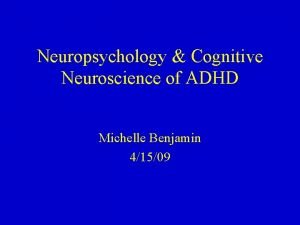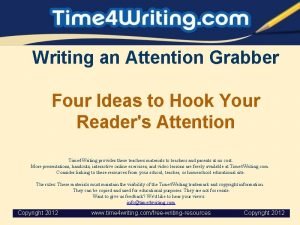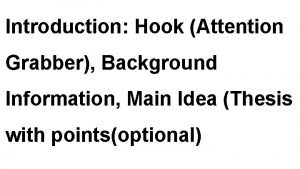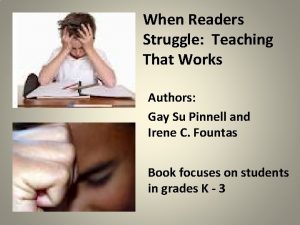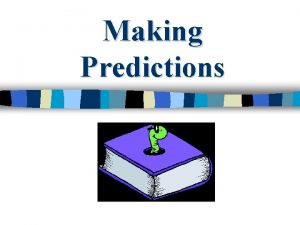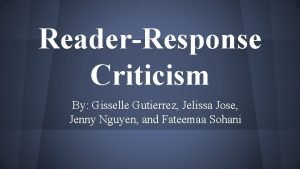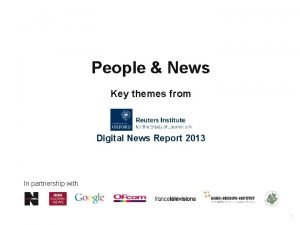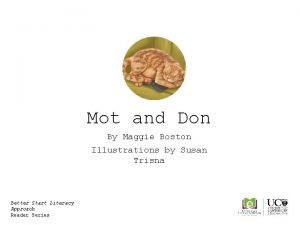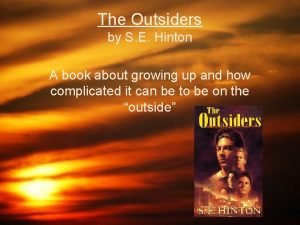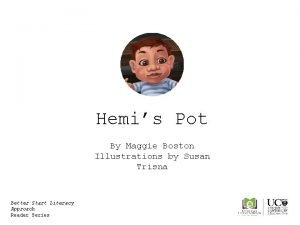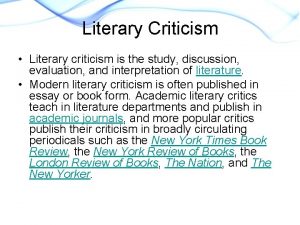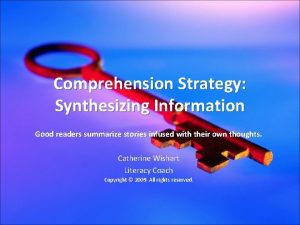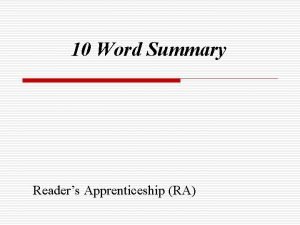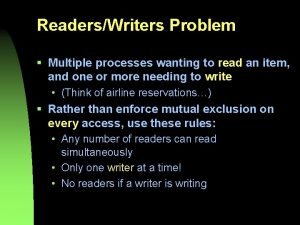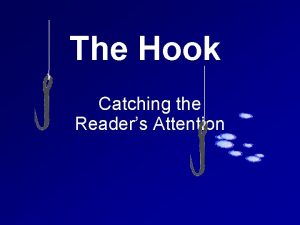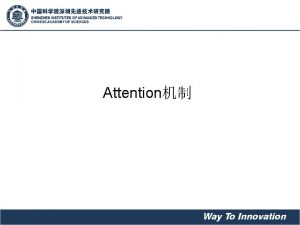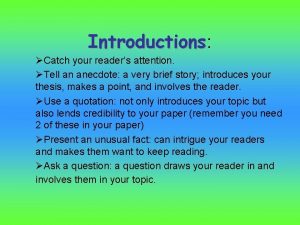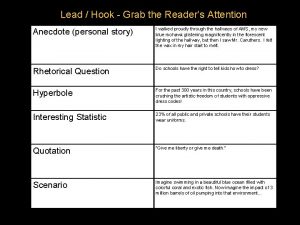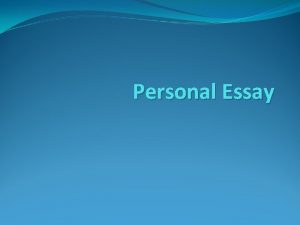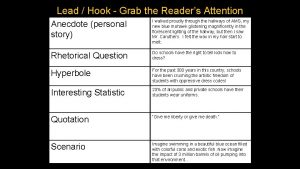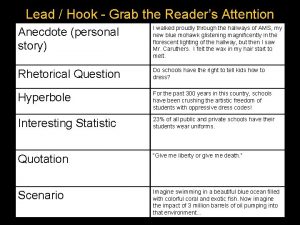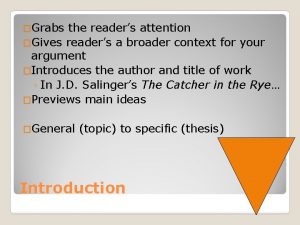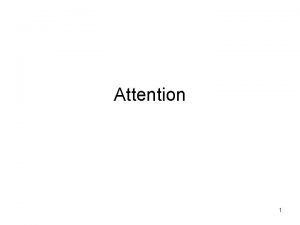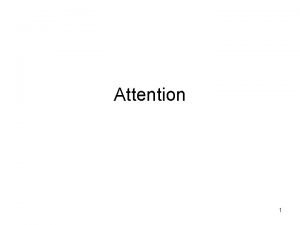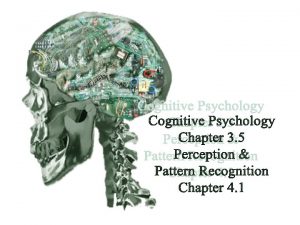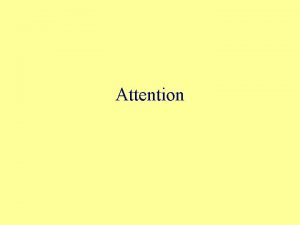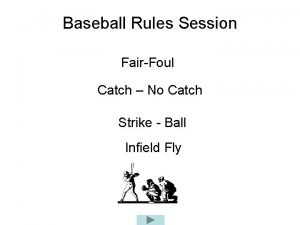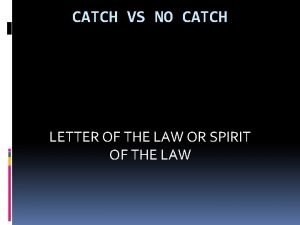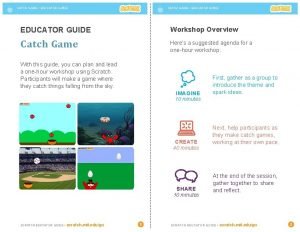The Hook Catch the readers attention The Hook




















- Slides: 20

The Hook Catch the reader’s attention!

The Hook To catch the reader, use a hook in the introductory paragraph. Ask the reader a question. Use a catchy phrase or quote. Create a tongue twister. Tell a personal anecdote (story). Go from general to specific.

The Hook: Question Ask the reader a question. Have you ever…?

The Hook: Question Ask the reader a question. Do you…?

The Hook: Question Ask the reader a question. Why would you…?

The Hook: Question Ask the reader a question. Would you…?

The Hook: Question Ask the reader a question. Can you…?

The Hook: Question Ask the reader a question. What do you…?

The Hook: Question Ask the reader a question. How would you…?

The Hook: Question My Best Friend Have you ever had a friend who could tell you what you were thinking? Do you have a friend you could call on at anytime? Can you think of someone who knows your deepest thoughts?

The Hook: Phrase or Quote Start your essay with an entertaining flair by using a catchy phrase. “Girls just wanna have fun” would describe my best friend.

The Hook: Anecdote (story) Tell the reader a short, personal story to catch his or her attention! I remember when my class worked together to create a mural on the wall by our school playground. I accidentally splashed a bucket of red paint near the bottom! One of my classmates came to the rescue and turned the splatter into a bunch of flowers. That is when I realized that mural painting is all about working together.

The Hook: Tongue Twisters This writing style is often called alliteration. Loving, laughing, and loyal would be my best friend in a nutshell.

The Hook: General to Specific Use deductive reasoning to hook the reader! Everyone looks forward to summer vacation. Many anticipate exciting vacations, while others plan to stay home and relax. Some even await lounging by the pool, soaking up the sun and reading the newest adventure novel. As for me…

The Hook In the introductory paragraph, use techniques that hook the reader. Ask a question. Use a catchy phrase or quote. Make up a tongue twister. Tell a short anecdote (story). Go from general to specific.

The Hook Use a hook to lure the reader into your essay.

Independent Practice: REVISION TIME! You already have a thesis statement. Now add your favorite hook to catch the reader’s attention. Remember, the hook goes FIRST. The thesis is the LAST sentence in the introduction. If you need to transition from the hook to thesis, add background information such as what honesty means.

5 -Paragraph Explanatory/Informative/Expository Essay Title (Topic: Specific Catchy Phrase) I. Paragraph 1 – Introduction-(3 sentences) A. Hook B. Background information about the topic C. Thesis statement/claim II. Paragraph 2 - First Point Body (5 -8 sentences) A. Transition and topic sentence (first Point) B. Two or three supporting sentences for the first point (evidence) C. reasoning • Paragraph 3 - Second point body (5 -8) sentences) I. A. Transition and second topic sentence (second point) II. B. Two or three supporting sentences for the second point III. (evidence) IV. C. Reasoning • Paragraph 4 - Third point body (5 -8 Sentences) II. A. Transition and third topic sentence (third point) III. B. Two or three supporting sentences for the third point (evidence) IV. C. Reasoning • Paragraph 5 - Conclusion (2 sentences) I. A. Transition and restatement of thesis sentence II. B. Clincher (catchy ending – Think about the big picture. )

Important Writing Terms Hook: A statement that grabs the reader’s attention. Thesis: An educated claim that announces your topic and main points about the topic. Clincher: Catchy ending-Think about the big picture.

 Critical reading meaning
Critical reading meaning Catch me once catch me twice
Catch me once catch me twice Alternating attention vs divided attention
Alternating attention vs divided attention Hook or grabber
Hook or grabber Hook attention grabber
Hook attention grabber When readers struggle
When readers struggle Good readers making prediction by
Good readers making prediction by Reader-response criticism example
Reader-response criticism example Inform persuade entertain
Inform persuade entertain Vivid writing examples
Vivid writing examples Civil war readers theater
Civil war readers theater Intensive reading in communication skills
Intensive reading in communication skills Online readers
Online readers Maggie boston readers
Maggie boston readers The outsiders adapted for struggling readers
The outsiders adapted for struggling readers Maggie boston
Maggie boston Advantages of literary criticism
Advantages of literary criticism Language features of news item text
Language features of news item text Reading comprehension synthesizing
Reading comprehension synthesizing Readers apprenticeship
Readers apprenticeship Readers writers problem
Readers writers problem


